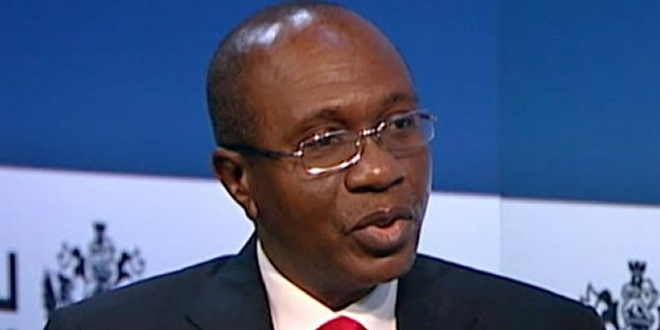
Global output growth remained weak in the second half of 2015 as evidenced by the decline in projected output growth to 3.1 per cent, lower than the 3.4 per cent recorded in 2014.
The decline was attributed to the general slowdown in economic activities in emerging markets and developing economies, China’s rebalancing of economic activities away from investment and manufacturing to consumption and services, declining oil and other commodity prices and the gradual tightening of US monetary policy.
Nigeria’s output growth declined to 2.47 per cent in the review period. Broad money supply increased, while the gross official reserves fell. The average exchange rate depreciated at the inter-bank and BDC segments. Year-on-year inflation rate edged up slightly to 9.6 per cent in the review period.
In the second half of 2015, average interest rates fell in response to the liquidity situation in the economy. Broad money grew by 5.90 per cent. Also, narrow money (M1) increased by 24.14 per cent at end-December 2015, as against the 5.25 per cent decline at the end of the first half of the year.
The Monetary Policy Rate (MPR) was reduced to 11.00 percent and the symmetric corridor of 200 basis points around the MPR was made asymmetric at + 200 basis points and -700 basis points for standing lending and deposit facilities, respectively. In reaction, rates at the inter-bank funds market fell in the review period.
These measures were to encourage banks to lend to the real sector of the economy. The intervention measures of the CBN were also sustained to enhance inclusive growth in the real sector. The quality of assets in the banking sector declined marginally in the second half of 2015 compared to the position at end-June 2015.
The decline in asset quality was attributed to the unfavourable macroeconomic environment in the review period. Also, capital adequacy weakened during the period. This was attributable to the fall in the level of banks’ general reserves.
A stress test of the banking industry revealed that, generally, it remained relatively resilient, although some banks were sensitive to credit concentration and interest rate risks which did not pose systemic threats to the industry.
The Bank continued to process customers’ complaints with a view to enhancing public confidence in banks. The payments system witnessed significant developments with the implementation of the Bank Verification Number (BVN) Scheme.
The Treasury Single Account (TSA), an initiative aimed at reducing the cost of government borrowing, better management of cash resources, and harmonized government receipts and payments, was fully implemented.
Generally, the global economy is expected to recover slightly in 2016, despite the prospect of rising interest rates in the US and economic slowdown in China.
However, the recovery could be dampened by possible decline in commodity prices which would further constrain growth in commodity exporting countries.
In Nigeria, the NBS projects a slight recovery in 2016. Economic activities are expected to pick up as the effects of government reform policies gradually impact on the real sector. In the foreign exchange market, the spread between the interbank and BDC rates is expected to narrow, as stability is restored in the market.
Macroeconomic Developments and Financial System Stability
Global Economic and Financial Developments
Output
Global output growth in 2015 remained weak. According to the IMF World Economic Outlook for 2015, the estimated output growth of 3.1 per cent was 0.3 per cent lower than the 3.4 per cent recorded in 2014.
The decline was attributed to the general slowdown in economic activities in emerging markets and developing economies, China’s rebalancing of economic activities away from investment and manufacturing to consumption and services, declining oil and other commodity prices and the gradual tightening of US monetary policy.
In advanced economies, the 2015 output growth estimate was revised downward to 1.9 per cent from the earlier projection of 2.1 per cent, slightly above the 1.8 per cent recorded in 2014.
The modest rebound in output reflected primarily a strengthening of recovery in the euro area and a gradual return to growth in Japan. Other contributory factors include declining oil prices, accommodative monetary policies and currency depreciation.
The pickup in output is expected to continue in 2016, particularly in North America. Output growth in advanced economies is projected at 2.1 per cent in 2016, which is 0.2 per cent higher than in 2015.
It is, however, anticipated that this projected recovery could be dampened by downside risks. Output growth in the US was expected to increase slightly from 2.4 per cent in 2014 to 2.5 per cent in 2015, despite strong second quarter growth of 3.9 per cent.
The marginal rise in output growth in the US economy was attributed to decline in oil prices, fall in the unemployment rate, weakened inflationary pressures, dollar appreciation, and increased household spending and industrial activities.
In the euro area, output growth was 1.5 per cent in 2015, compared to 0.9 per cent in 2014, reflecting sustained recovery supported by stronger private consumption, lower oil prices and easing financial conditions that outweighed a weakening in net exports. In 2016, the euro area is expected to expand by 1.7 per cent.
In the UK, growth weakened from 2.9 per cent in 2014 to 2.2 percent in 2015 and was estimated to remain at the same rate in 2016. In Japan, output growth rose to 0.6 percent in 2015 from its zero-growth level in 2014. This reflected the rebound in domestic spending arising from quantitative and qualitative policy measures adopted during the review period.
Output growth in emerging markets and developing economies was estimated at 4.0 per cent in 2015, compared to 4.6 per cent recorded in 2014. The slowdown in output growth reflected difficult external conditions, sharp rise in financial market volatility, declining commodity prices and downward pressure on many of their currencies. Other factors were low capital inflows and the effect of the lift-off of US policy rates from the zero lower bound.
Growth in China slowed to 6.9 per cent in 2015 from 7.3 per cent in 2014, reflecting, among others, the decline in investment growth and weak exports. In Latin America, the economic downturn in Brazil was deeper than expected, and with declining commodity prices, the momentum continued to weaken in other countries in the region. Output growth in Brazil decelerated to -3.8 per cent in 2015 from 0.1 per cent in 2014.
Mexico’s growth of 7.5per cent in 2015 was lower than expected, reflecting slower US growth and a drop in oil production. In Russia, output growth declined from 0.6 per cent in 2014 to -3.7 per cent in 2015, owing largely to declining commodity prices and the political turmoil in the region.
The output growth in India, at 7.3 per cent in 2015, the same as in 2014, was supported by a strong expansion in the manufacturing and services sectors. The Middle East and North Africa (MENA) region witnessed a decline in output growth from 2.8 per cent in 2014 to 2.5 per cent in 2015, owing to low oil prices and political instability in several countries.
Also, output growth in sub-Saharan Africa (SSA) in 2015 was lower than projected, as it declined to 3.5 per cent from the 5.0 per cent recorded in 2014. This was largely attributed to the fall in crude oil prices, which affected oil exporting countries like Nigeria and Angola.
GDP growth in South Africa was estimated at 1.3 per cent in 2015 compared with 1.5 per cent in 2014, while in Nigeria it was estimated to decline to 3.01 per cent in 2015 from 6.3 per cent in 2014.
Global Inflation
Global inflation generally remained low throughout 2015, reflecting the continued decline in oil prices and low aggregate demand. For most part of 2015, inflationary pressures remained relatively low in China and advanced economies, but rose slightly in several emerging markets and developing economies.
In the advanced economies, headline inflation fell to 0.3 percent in 2015from 1.4 per cent in 2014, owing to the sharp decline in commodity prices and the hedging downwards of market based measures of inflation expectations. Core inflation remained stable at low levels, reflecting persistent economic slowdown and weak import prices, particularly in the US where the effective exchange rate had appreciated by about 15 per cent over the past year.
Core inflation is expected to remain weak in 2016, but could edge up marginally if economic conditions improve. Inflation in advanced economies was projected at 3.7 per cent for 2016. Inflation in the US which was 1.6 per cent in 2014, dropped to 0.1 per cent in 2015 but is expected to rise to 1.1 per cent in 2016 as the Federal Reserve raises interest rates.
Overall, the inflation rate in most advanced economies remained below their respective central banks’ targets for 2015. In the euro area, inflation declined to 0.2 per cent in 2015 from 0.4 per cent in 2014 but is expected to rise to 1.0 per cent in 2016, as economic conditions improve.
Similarly, inflation in the UK moderated to 0.1 per cent in 2015 from 1.5 per cent in 2014 and is projected to rise to 1.5 per cent in 2016. Inflation in the euro area, however, remained within the European Central Bank (ECB) target of 2.0 per cent for 2015. In Japan, inflation declined from 2.7 per cent in 2014 to 0.7 percent in 2015 and is estimated to decline further to 0.4 per cent in 2016.
Inflation in the emerging markets and developing economies rose from 5.1 per cent in 2014 to 5.6 per cent in 2015 but is expected to slow down to 5.1 per cent in 2016. In China and India it remained subdued, while in Brazil and Russia inflation was elevated as currency depreciations pushed up import prices.
During the review period, the average inflation rate of emerging markets and developing economies at 5.6 per cent was higher than the 3.0 per cent inflation target of many of their central banks and the 5.5 per cent recorded in 2014.
In the MENA region, inflation remained at 6.5 per cent in 2015 as was in 2014, despite the persistent social and political crises in the region.
In sub-Saharan Africa, inflation rose from 6.4 per cent in 2014 to 6.9 per cent in 2015, reflecting the pickup of inflation in Nigeria and Angola, the region’s largest oil exporters. However, among oil importers, the impact of falling oil and commodity prices drove down inflation marginally by the end of 2015.In Nigeria, inflation rose from 8.1 per cent in 2014 to 9.6 per cent in 2015.
Global Commodity Prices
The decline in key commodity prices witnessed in the first half of 2015 continued throughout the second half, with the lowest decline of 5.42 per cent in agriculture and the highest of 40.35 per cent in crude oil.
In terms of average changes between June and December 2015, energy prices declined by 37.30 per cent as the index values dropped from 76.35 at end-June 2015 to 47.87 at end-December 2015, while agricultural output fell from 90.18 at end-June 2015 to 85.29 at end-December 2015.
Food prices dropped by 5.76 per cent and those of precious metals fell by 10.32 per cent during the review period
Oil
World crude oil demand in December2015 was 92.9 mbd compared with 92.5 mbd in June2015, reflecting an increase of 0.43 per cent. World oil supply rose by 3.0 per cent to 94.9 mbd in December 2015 from its level in June 2015. The increased demand was partly due to higher demand from the US and other advanced economies, while the increase in world supply was due to better-than-expected growth in supply from the US, Canada, Russia and Norway.
The OPEC Reference Basket (ORB) averaged $33.64/b in December 2015 compared with $60.21/b in June 2015. The significant decline in oil price was due to oversupply in the oil market, appreciation of the US dollar and downturn in equity markets.
Developments in Crude oil futures contracts indicated significant decline in oil prices. ICE Brent ended December 2015 at $38.90/b compared with $63.5/b in June 2015, while Nymex WTI settled at $37.33/b in December 2015 compared with $59.83/b in June 2015.
Food
The Food and Agriculture Organization (FAO) Food Price Index (FPI) averaged 154.1 points, reflecting a decline of about 6.5 points when compared with 164.9 in June 2015. The decline was linked to the glut in global supply amidst weak demand and a strong US dollar.
The FAO Meat Price Index for December 2015 averaged 152.1 points, down 10.3 points when compared with the 169.5 in June 2015. It was observed that for most part of the second half of 2015, quotations fell for all categories of meat.
The FAO Dairy Price Index averaged 149.5 points in December 2015, down by 6.9 points when compared with 160.5 in June 2015. The decline stemmed from a fall in prices for milk powders. The weak demand for whole milk powder dairy products led manufacturers to focus on producing other dairy commodities.
The FAO Cereal Price Index, which averaged 151.6 in December 2015, lost 7.1 points when compared with 163.2 in June 2015. Expectation of larger supplies entering world markets following the removal of export taxes in Argentina weighed on wheat quotations. Maize prices also fell in December, amid intensifying export competition and sluggish international demand.
The FAO Vegetable Oil Price Index averaged 141.1 points in December 2015, reflecting a decrease of 9.7 per cent from 156.2 points in June 2015. However, international palm oil prices remained stable, as concerns about possible production decline in Southeast Asia were counterbalanced by weak global import demand.
The FAO Sugar Price Index averaged 207.8 points in December 2015, which was 17.5 per cent higher than the 176.8 recorded in June 2015. The driving forces behind international sugar prices were continued concerns over harvesting delays in the South-Central producing regions in Brazil, caused by excessive precipitation







Comments are closed.